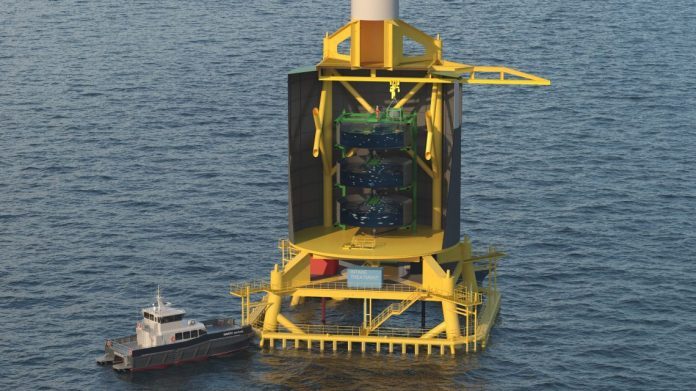The facility, which has been named “Aqua Wind Tower”, was developed in collaboration with, among others, the Highlands and Islands Enterprise in Scotland, which is the Scottish Government’s development agency for economy and society.
An “Aqua Wind Tower” is installed by placing a bottom frame on the seabed. This extends over the water surface. Here, the frame for the fish farm is put on, including the feed tanks, which contain fish feed for a month. Then the frame of the wind turbine is mounted over, before the blades and the motor itself is mounted.
As the fish grows, it will gradually move down the tank system. This is done by draining the water where the fish stand and moving it by gravity to the tank below.
The plant is automated, but if anyone needs access to it, the engine slows down and power generation stops. The same battery pack will be fitted as found in modern ferries, and there should also be a generator set if needed.
Seawater is collected from 45 meters and pumped individually into the tanks to avoid sea lice, algae, and parasites. When the water is released again, it goes through six pumps in reverse, which are mounted inside the bottom frame legs. According to the developers, 60 percent of electricity consumption is then recovered.

5,000 tonnes of salmon annually
Initially, there will be a trial project, where two installations will be tested on the east coast of Scotland, about 2.5 kilometers off shore. The concept project for Scotland will be production from post-smolt at 600 grams, to harvest at 5,5 kilos, by the use of seawater flow true.
In the long term, the plan is to produce 5,000 tonnes of salmon annually in 15 of these installations.
“The advantage of this solution is that you need the bottom frame anyways, but instead of just using the area and the bottom frame for wind energy production, you produce salmon in a closed installation,” says Heerema development director, Arne Ramstad, to SalmonBusiness.
Ramstad believes the solution can work with RAS-technology on land as well.
“But we take it one step at a time,” he says.
Interest
Ramstad believes there is a global interest in such a solution because it is possible to farm local species while providing electricity to remote areas.
“We do not stress, but we have interest from both green energy companies and from the official authorities, who are looking for sustainable fish farming solutions,” Ramstad claims.
Ramstad further states that the company has also had interest from Norway.
“But as I understand it, it’s a long way to go before offshore wind parks are an alternative for Norway,” he concludes.
SalmonBusiness have tried to reach out for a comment from the Highlands and Islands Enterprise in Scotland about their involvement in the project.
“As you will appreciate, any discussions we have with businesses are done in confidence so it would be inappropriate for me to make a statement”, wrote Elaine Jaimeson in HIE in an e-mail to Salmonbusiness.


